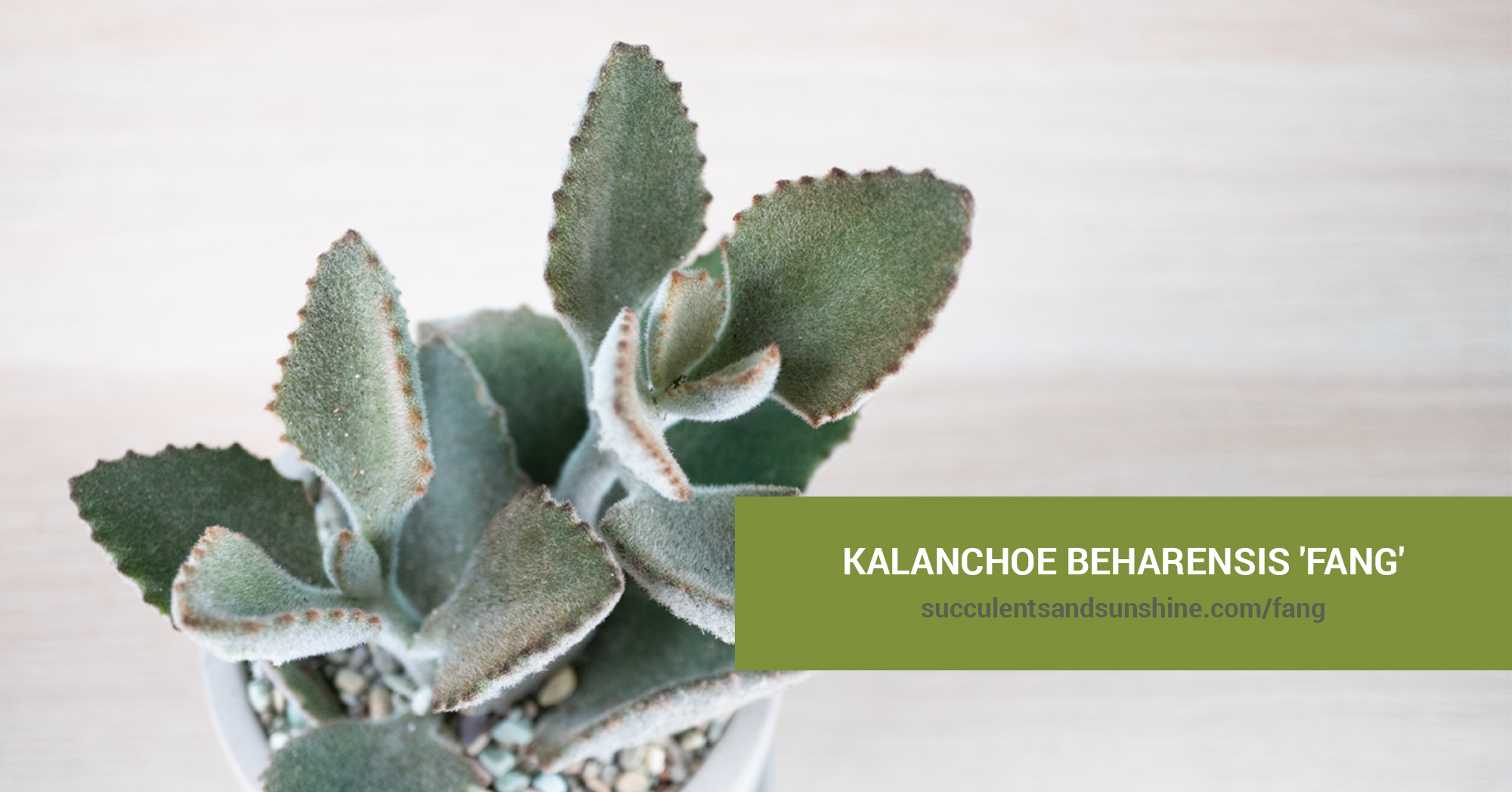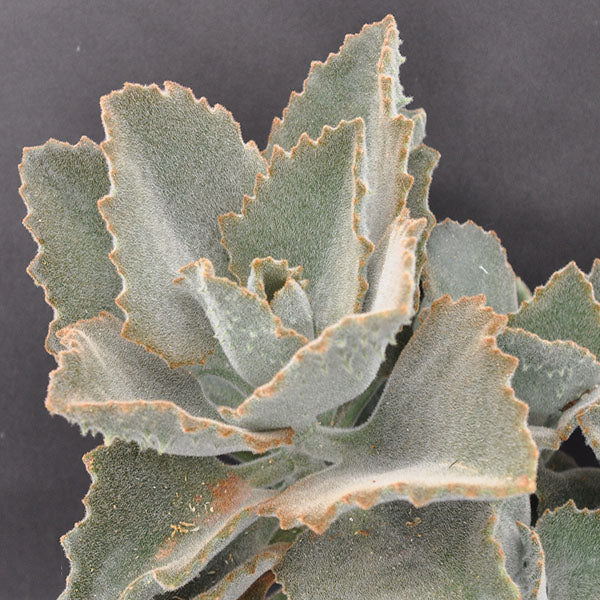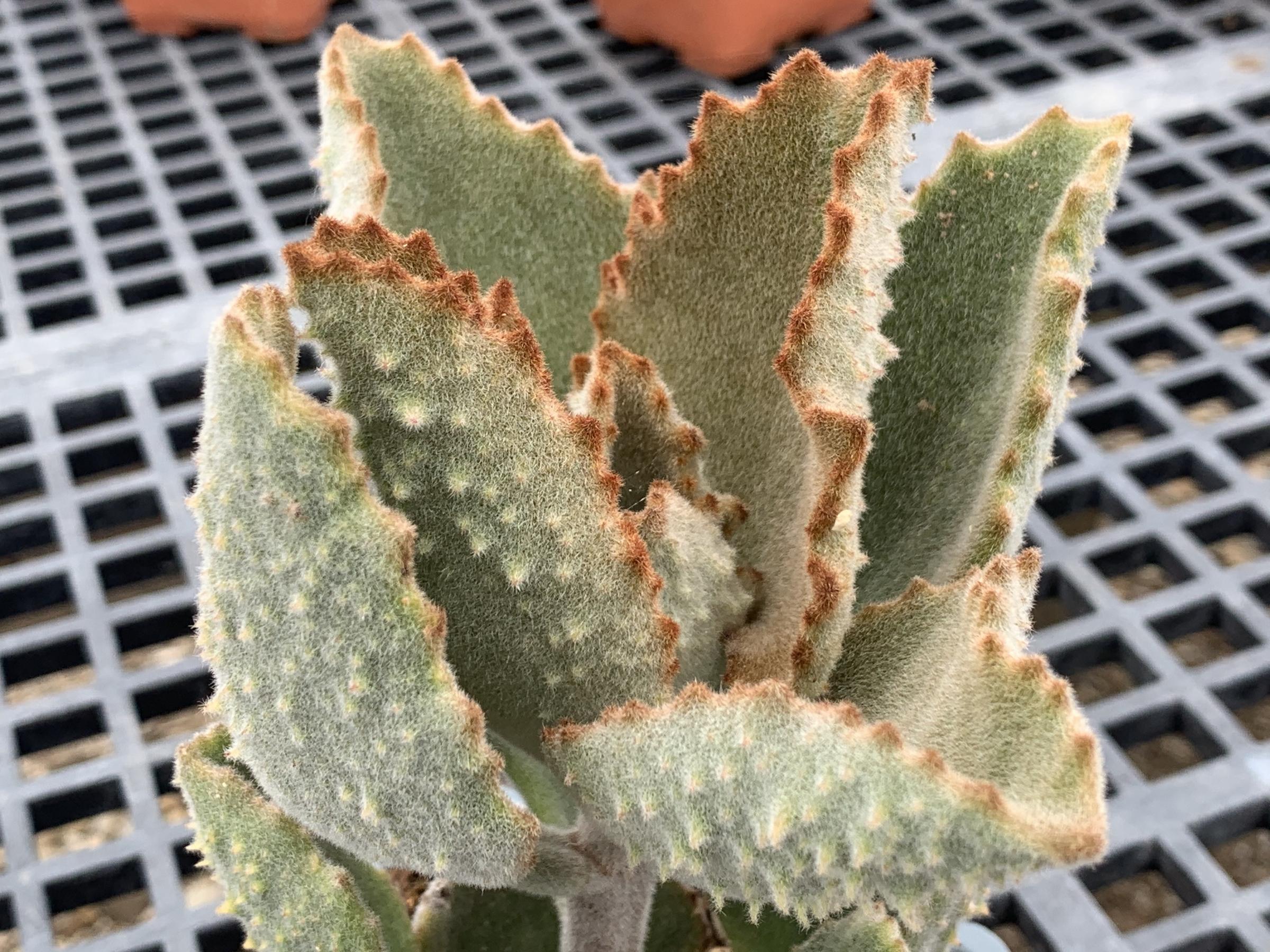This tall succulent has silver leaves with small bumps, or “fangs,” along the margins and underside. The edges of the leaves have a bronze hue. If planted outside, ‘Fang’ produces red-orange blooms in the Spring. When growing indoors, it’s uncommon to witness the blossoms.
Table of Contents
Care and Propagation Information
Kalanchoe beharensis ‘Fang’ is an ideal houseplant, as it thrives indoors. In bright light, its foliage takes on a bronze hue, in contrast to its silvery hue when kept in dimmer conditions. It also looks beautiful in outdoor garden beds and containers.
Watering
Kalanchoe beharensis ‘Fang’ requires typical watering for a succulent; it’s best to use the “soak and dry” technique, meaning that the soil should be completely dry between waterings.
Where to Plant
If you live in an area where the temperature drops below 20° F (-6.7° C), it is advisable to put this succulent in a pot that can be moved indoors. It is best to place it in an area where it will receive full or partial sunlight.
How to Propagate Kalanchoe beharensis ‘Fang’
Kalanchoe beharensis ‘Fang’ can be reproduced by taking stem cuttings or leaves, but stem cuttings usually produce the best results.
Cuttings
To propagate ‘Fang’ from cuttings, employ a sterilized, sharp knife or scissors. Cut off a stem from the main plant, and let it seal off for a few days before positioning in a well-draining potting mix. Don’t forget to irrigate the soil every time it completely dries out.
Leaves
To ensure the successful propagation of ‘Fang’, twist off a leaf from the main plant, making sure that none of it remains on the stem.
Allow the leaf to sit and air dry for a couple of days until the end has sealed off and then place it on a soil bed that has good drainage. Water the soil only when it has dried out completely.
Commonly Mistaken For
Care and Propagation Information
General Care for Kalanchoe beharensis ‘Fang’
Kalanchoe beharensis ‘Fang’ is an ideal houseplant, as it thrives indoors. In bright light, its foliage takes on a bronze hue, in contrast to its silvery hue when kept in dimmer conditions. It also looks beautiful in outdoor garden beds and containers.
Watering
Kalanchoe beharensis ‘Fang’ requires typical watering for a succulent; it’s best to use the “soak and dry” technique, meaning that the soil should be completely dry between waterings.
Where to Plant
If you live in an area where the temperature drops below 20° F (-6.7° C), it is advisable to put this succulent in a pot that can be moved indoors. It is best to place it in an area where it will receive full or partial sunlight.
How to Propagate Kalanchoe beharensis ‘Fang’
Kalanchoe beharensis ‘Fang’ can be reproduced by taking stem cuttings or leaves, but stem cuttings usually produce the best results.
Cuttings
To propagate ‘Fang’ from cuttings, employ a sterilized, sharp knife or scissors. Cut off a stem from the main plant, and let it seal off for a few days before positioning in a well-draining potting mix. Don’t forget to irrigate the soil every time it completely dries out.
Leaves
To ensure the successful propagation of ‘Fang’, twist off a leaf from the main plant, making sure that none of it remains on the stem.
Allow the leaf to sit and air dry for a couple of days until the end has sealed off and then place it on a soil bed that has good drainage. Water the soil only when it has dried out completely.
Commonly Mistaken For
is a succulent shrub
Kalanchoe beharensis ‘Roseleaf’ is a succulent-type shrub.
FAQ
Is Kalanchoe dog toxic?
Kalanchoe are known to possess hazardous substances that can have a detrimental effect on the heart, similar to those found in oleander and foxglove. Incidents of poisoning have been noted in canines (which are very vulnerable to such toxins), rabbits, chickens, domesticated animals, and even reptiles.
What if a dog eats a kalanchoe?
If your dog ingests any part of the kalanchoe plant, it can lead to an imbalance in electrolytes, resulting in irregular heart rate, seizures, and in some cases death. In addition to the cardiac symptoms, it can also cause gastrointestinal distress and neurological issues.
Is kalanchoe poisonous pets?
Kalanchoe species contain poisonous cardiac glycosides, making them potentially dangerous for animals.
How do you care for Kalanchoe beharensis Fang?
Grow in soils that drain well and receive anywhere from full sunlight to partial shade. Thoroughly moisten the soil during the growing season, allowing it to dry out in between waterings. Water sparingly during the winter, just enough to keep the soil moist. Fertilize with a balanced fertilizer 3-4 times during the spring, summer, and early fall.



